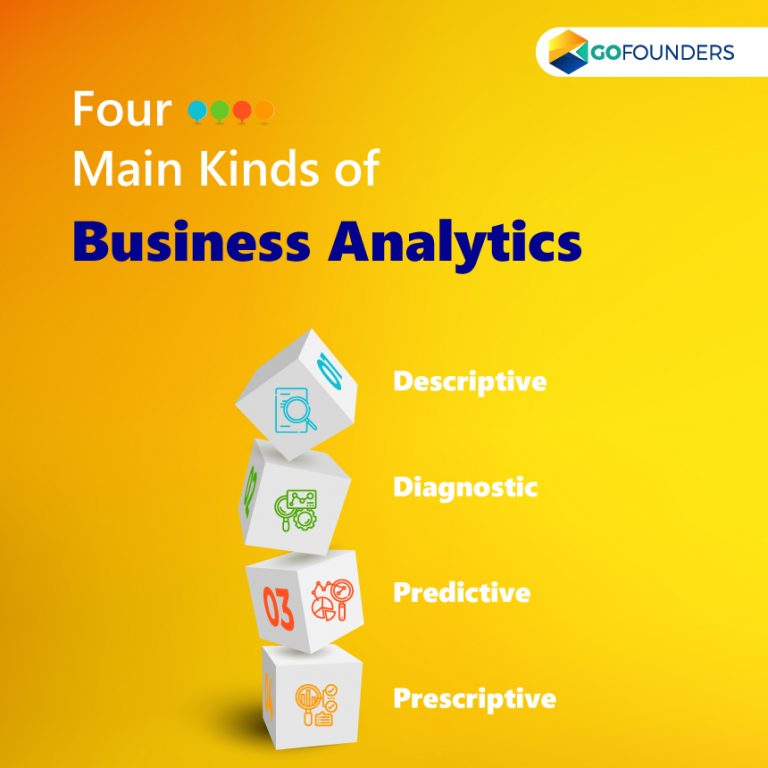
If you are a growing enterprise, you might exploit business analytics to improve strategic decision-making. Business analytics is a process that enables businesses to use statistical data and advanced technologies to analyze data in the past to obtain new insights for the advancement of the business.
There are four key types of business analytics that works on vast amount of data. They are:
- Descriptive analytics (help to answer what has happened)
- Diagnostic Analytics (helps to answer why did it happen)
- Predictive Analytics (help to answer what happens if)
- Prescriptive Analytics (help to answer how to make it happen)
Let’s dive into the article to get to know them in detail.
1. Descriptive Analytics
This is one of the simplest type of analytics. It provides a recap of the main findings and comprehends what is going on. It also extracts comprehensible pieces of information from a sea of complex data.
Interestingly, advanced analytics or business intelligence is nothing but the usage of descriptive statistics (including different arithmetic operations) on present data. It has found that about 80 % of business analytics majorly involves descriptions based on consolidations of past execution. It is crucial to provide raw data in an understandable way so that investors, managers, and other stakeholders can strategize rightly.
It incorporates two techniques mainly viz. data aggregation and data mining which provides information to decode underlying behaviour and not reallly make any predictions. Data mining, help companies with targeted marketing by analyzing consumer behaviours.
The tools employed for this phase are MS Excel, STATA, SPSS, MATLAB, etc.
2. Diagnostic Analytics
Diagnostic analytics help businesses with reasoning aspect like, why did something happen in the past. It can be described by various techniques including data discovery, data mining, drill-down, and correlations. Unlike descriptive analytics, it goes deeper and understands the fundamental causes of the events. It provides factors and events that caused a specific outcome.
For example, diagnostic analytics may help you find the reasons your sales have raised or decreased for a specific period of business operations. However, it has limitations when it comes to providing actionable insights.
Some techniques such as principal components analysis, conjoint analysis, sensitivity analysis and attribute importance employ diagnostic analytics. Also, training algorithms for categorization and regression come under the ambit of this type of analytics.
3. Predictive Analytics
As understandable from its name, predictive analytics gives predictions about future outcomes. However, it is imperative to know that it is not able to predict if an event will take place in the future but simply predicts all are the possibilities that an event may take place. It builds a predictive model based on the initial descriptive analytics stage to obtain the probability of the outcomes.
Application of predictive analytics is visible in sentiment analysis where all the views expressed on different social media platforms are gathered and analyzed (existing data in the form of text) to predict user’s sentiment about a specific issue- if it’s positive, negative or neutral (future prediction).
Thus, predictive analytics facilitates the building and validation of models which offers accurate predictions. It makes use of machine learning algorithms such as random forests, statistics, SVM, etc for the purpose. Python, RapidMiner are among the most popular predictive analytics tools.
If tuned rightly, it builds a model that can avail complex predictions in sales and marketing.
4. Prescriptive Analytics
The base of this analytics is predictive analytics. However, it goes a step ahead and suggests all desired outcomes based on the described course of action. It can also suggest a set of actions to reach a particular outcome. For that to provide, it exploits a strong feedback system that constantly learns and revise the relationship between actions and outcomes.
It employs an optimization approach to reach the desired outcome. Also, it incorporates simulation where all the key functional areas are combined to design the right solutions. It ensures if key function metrics are involved in the solution.
Conclusion
The four analytics techniques explained in the article may not necessarily be implemented sequentially. You can directly jump on to implement prescriptive analytics. It has shown that prescriptive analytics is still at its development stage and not many companies have utilized its full potential. However, the progress in predictive analytics will help it develop in near future. By employing these four analytics, businesses can make the right strategic decisions and achieve the desired efficiency.


